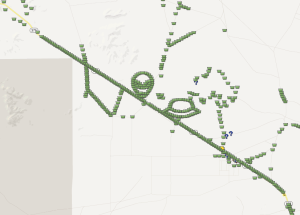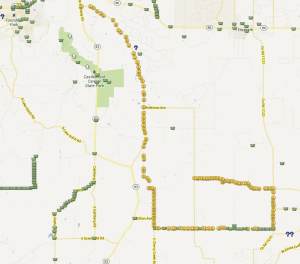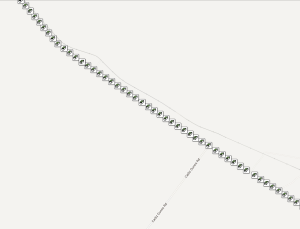A Power Trail is a set of consecutive caches along a route that allows cachers to find a large number of caches in a small amount of time and distance. They are usually placed right at or just over the 528 feet limitation from the previous and next cache. The difficulty and terrain levels are kept low to increase the ease of finding the containers.
Power Trails may consist of a couple dozen to over 1500 caches depending on the trail. The ET Highway Power Trail was once shut down, due to safety reasons by the, Nevada Department of Transportation. The outcry from business owners along the trail in several towns, along with Geocachers all over the world sparked the return of the grueling caching phenomenon.
Power Trails are a force that will eat your lunch if you are not prepared! So, let’s get you ready (NOTE: Contact a cacher who has completed the Power Trail you want to attempt to gain valuable insight).
1. Carefully research the trail in question. Define where the trail begins and ends usually by cache number/name but could be by intersection or city.
2. Account for weather changes as the day progresses. We did a Power Trail in Colorado where it was -7 degrees (F) when we started and 50 degrees when we signed the last log. A lot of times the cache containers for these trails are 35 mm canisters and opening the lids with frozen fingers can present some challenges. Prepare for the weather with the appropriate clothing.
3. Develop your driving route. (If your Power Trail begins and ends on the same road or highway you are done with this step). If the trail has sub trails due to intersecting roads or highways, you will have to determine how to approach to maximize your time and decrease your effort. You may have to double back later to clean up some earlier skipped caches. A mistake we made was overlooking driving time from one part of the trail to another. We drove almost 45 minutes without a cache find. This was precious time wasted when the Sun’s setting was imminent. Some GPS receivers will calculate the best route between Geocaches or your waypoints as points of interest. Fuel is another concern. Some trails will have you drive for along time to just get to where the first cache is. Plan your fuel stops carefully. Most cachers carry several auxiliary containers of fuel in the trunk, cargo area, or strapped to the roof when caching the ET Highway Power Trail. Remember to be safe!
3. Define roles for your team. If you are going at it alone, you are done with this step but need to be aware of what will be required of you. Here are some functions to consider:
4. Driver – All traffic, speed, parking laws must be obeyed at all times. The driver does not get out of the car except for predetermined stops (restroom breaks). The driver should have a navigational GPSr loaded with all the caches for the trail. This way they can gauge when to start slowing down and which side of the road the cache is on. Even though we live in a paper-less caching society, the driver should have a printout of the caches in order of their appearance. Programs like GSAK (download for free here) can include customized details of all the caches and the driver should be previewing the next cache while the other team members are finding the current cache. It is the driver’s responsibility to keep track of the number of caches found and to notate milestones for each team member on the printout. The driver will also need to measure the FPH (Finds Per Hour) rate to ensure a successful completion of the trail in the allotted time. To give the driver credit for finding the cache, some cachers create a team name in which to sign the log. The driver watches in order to see the container or log. Other cachers maintain that since the driver did not physically touch the cache, they cannot log it as found. Play per your own convictions.
5. Finders – Finders will exit the vehicle, find the cache, show the container to the driver, sign the log, replace the cache and return to the vehicle as fast as possible. They call out the name of the next cache and wait for confirmation from the driver. Finders provide traffic information to the driver to decrease the chances of pulling out in front of other vehicles. Usually Finders sit on the right side of the vehicle (left side for those countries that drive on the left) for safety reasons. Avoid people exiting the side with traffic. Finders will cater to the driver since the driver has responsibilities that keep them in their seat. Food, water, etc. are given to the driver when it is safe to do so.
6. Power Trails offer a challenging yet rewarding experience to all who participate. Remember that you will get fatigued getting in/out of the car a few hundred or thousand times. Your relationship with your fellow team members will be tested during this stress induced activity. Stay hydrated, eat small amounts of food often, and don’t forget your sense of humor.
There are as many Power Trail plans as there are Geocachers and we hope that these basic elements will aid you in your quest for conquering the mighty beast. Safety has to be the driving force (sorry for the pun, no not really) behind all of your actions so stay sharp and enjoy the ride.



